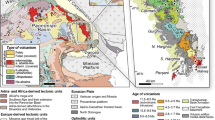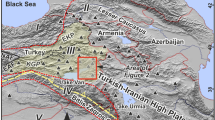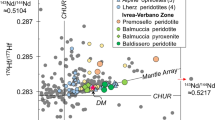Abstract
High mantle potential temperatures and local extension, associated with the Late-Cretaceous impact of the Trindade mantle plume, produced substantial widespread and voluminous magmatism around the northern half of the Paraná sedimentary basin. Our previous studies have shown that, above the central and eastern portions of the postulated impact zone where lithosphere extension is minimal, heat conducted by the plume caused large-scale melting of the more fusible parts of the subcontinental lithospheric mantle beneath the margin of the São Francisco craton and the surrounding Brasilía mobile belt. Here we combine geochemical data and field evidence from the Poxoreu Igneous Province, western Brazil to show how more intense lithospheric extension above the western margin of the postulated impact zone permitted greater upwelling and melting of the Trindade plume than further east. Laser 40Ar/39Ar age determinations indicate that rift-related basaltic magmas of the Poxoreu Igneous Province were emplaced at ˜ 84 Ma. Our detailed geochemical study of the mafic magmas shows that the parental melts underwent polybaric crystal fractionation within the crust prior to final emplacement. Furthermore, some magmas (quartz-normative) appear to have assimilated upper crust whereas others (nepheline- and hypersthene-normative) appear to have been unaffected by open-system crustal magma chamber processes. Incompatible trace element ratios (e.g. chondrite-normalised La/Nb = 1) and isotopic ratios (87Sr/86Sr = 0.704 and 143Nd/144Nd = 0.51274) of the Hy-normative basalts resemble those of oceanic islands (OIB). We therefore propose that these “OIB-like” magmas were predominantly derived from convecting-mantle-source melts (i.e. Trindade mantle plume). Inverse modelling of rare-earth element (REE) abundances suggests that the initial melts were predominantly generated within the depth range of ˜80–100 km, in mantle with a potential temperature of ˜1500 °C.
Similar content being viewed by others
Author information
Authors and Affiliations
Additional information
Received: 12 April 1996 / Accepted: 9 September 1996
Rights and permissions
About this article
Cite this article
Gibson, S., Thompson, R., Weska, R. et al. Late Cretaceous rift-related upwelling and melting of the Trindade starting mantle plume head beneath western Brazil. Contrib Mineral Petrol 126, 303–314 (1997). https://doi.org/10.1007/s004100050252
Issue Date:
DOI: https://doi.org/10.1007/s004100050252




